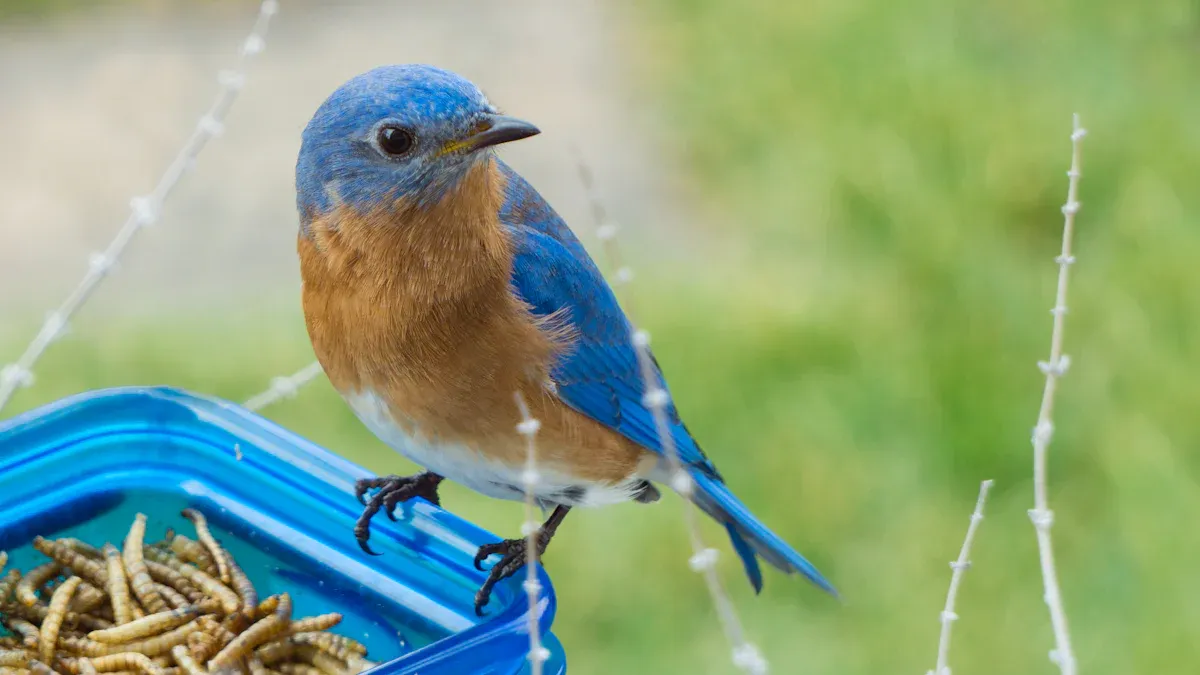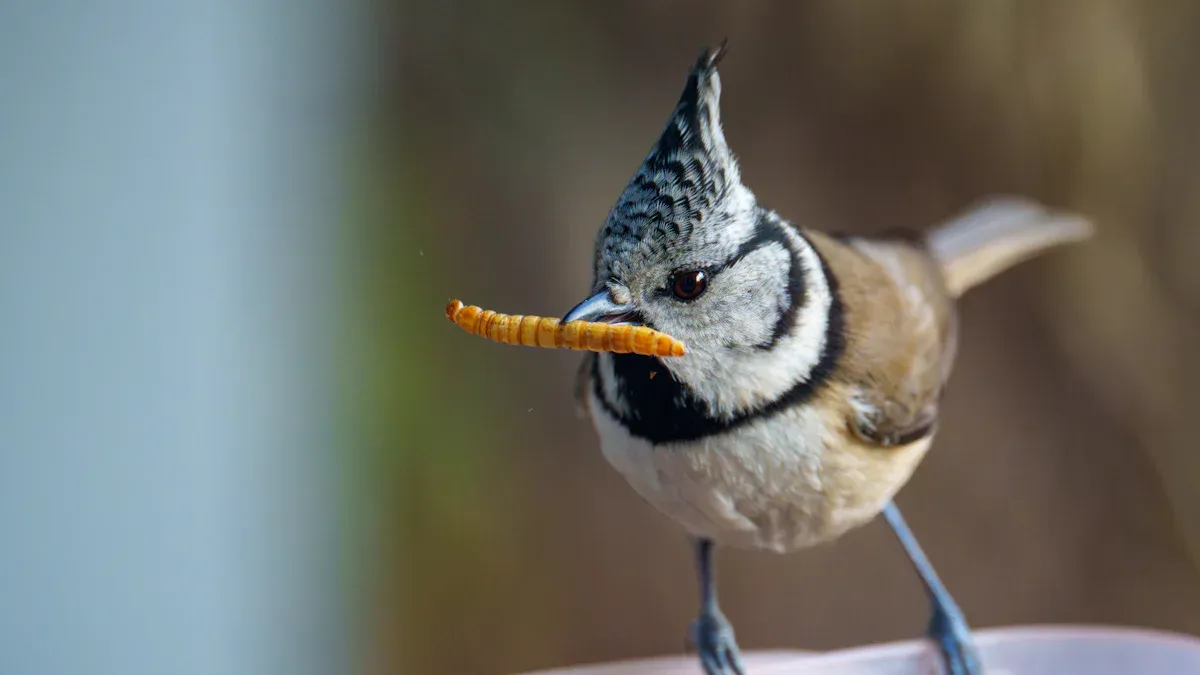
Protein plays a vital role in a bird’s health, supporting growth, energy, and feather maintenance. Dried mealworms, known for their impressive mealworm protein content of 53%, offer a convenient and nutrient-rich option. Birds especially benefit from this high-protein treat during molting or nesting seasons, ensuring they stay strong and healthy year-round.
Key Takeaways
- Dried mealworms have 53% protein, a great food for birds. They are especially helpful during molting and nesting times.
- Pick good-quality dried mealworms to give birds key nutrients. Check for clear labels and stay away from added chemicals.
- You can feed them in different ways. Use feeders for safety, spread them on the ground for natural eating, or mix with seeds for a healthy diet.
Why Protein Matters for Birds
Role of Protein in Bird Health
Protein is a cornerstone of a bird’s diet. It supports nearly every aspect of their health, from muscle development to immune function. Birds rely on protein to repair tissues, build strong muscles, and maintain their overall vitality. Without enough protein, their bodies struggle to perform these essential tasks. Scientific studies highlight the importance of protein-rich diets for birds. For example, research on the nutritional quality of invertebrates shows a direct link between the nutritive value of insects and the health of nestling birds. Additionally, studies emphasize the need for proper supplementation to prevent deficiencies in captive birds.
| Study Focus | Findings |
|---|---|
| Nutritional quality of invertebrates | Correlation between the nutritive quality of earthworms and insects fed to nestling birds. |
| Nutritional deficiencies | Diseases in captive insectivores due to poor vitamin and mineral content in feeder insects. |
Benefits for Growth, Energy, and Feather Maintenance
Protein plays a vital role in growth, energy, and feather health. Young birds, like finches, need protein to grow strong muscles and tissues. Mealworms, with their high mealworm protein content, provide a rich energy source that keeps birds active and healthy. They also contain essential fatty acids that promote vibrant feathers and healthy skin.
| Benefit | Description |
|---|---|
| Growth | Protein is essential for the growth and repair of muscles, organs, and tissues, especially in young finches. |
| Energy Levels | Mealworms provide a rich source of protein that supports overall energy levels in finches. |
| Feather Maintenance | Essential fatty acids in mealworms contribute to skin and feather health, promoting vibrant feathers. |
Recognizing Protein Deficiency in Birds
Protein deficiency can lead to noticeable changes in birds. They may appear lethargic, lose weight, or develop brittle feathers. In severe cases, their immune systems weaken, making them more prone to illness. Providing a protein-rich diet, such as dried mealworms, helps prevent these issues and keeps birds thriving.
Mealworm Protein Content vs. Other Bird Food Options
Comparing Dried Mealworms and Seeds
When comparing dried mealworms to seeds, the difference in nutritional value becomes clear. Seeds are a common bird food, but they lack the high protein content that dried mealworms provide. While seeds are rich in carbohydrates and fats, they fall short in delivering the essential protein birds need for growth and energy.
- Key Differences:
- Dried mealworms offer higher protein and fat content, making them a more balanced option.
- They are especially beneficial for birds like finches that require extra protein during molting or nesting seasons.
- Seeds, while nutritious, cannot match the protein density of dried mealworms.
This makes dried mealworms a superior choice for bird enthusiasts looking to provide a protein-packed diet.
Dried Mealworms vs. Live Insects
Dried mealworms also outperform live insects in terms of nutritional value. Live mealworms contain about 20% protein, while dried mealworms boast an impressive 53% protein content.
| Type | Moisture | Lipid | Protein | Ash | Carbohydrate |
|---|---|---|---|---|---|
| Live mealworms | 62% | 13% | 20% | 1.5% | 3.1% |
| Dried mealworms | 5% | 28% | 53% | 4.1% | 8.5% |
The drying process removes moisture, concentrating the nutrients and making dried mealworms a more efficient protein source. They also have a longer shelf life, making them a convenient option for bird feeders.
Why Dried Mealworms Are a Superior Protein Source
Dried mealworms stand out as a top-tier protein source for birds. Their high protein content, combined with essential amino acids and fatty acids, supports birds’ overall health. Studies show that dried mealworms provide a better nutritional profile compared to other protein sources.
| Source | Protein Content (DM basis) | Notes |
|---|---|---|
| Yellow Mealworms | ~50% | Excellent protein source for birds |
| Avian Mash | 44.6% (day 2) to 16.3% (day 10) | Protein declines significantly over time |
Birds benefit greatly from the concentrated nutrients in dried mealworms. They are easy to store, simple to serve, and packed with the mealworm protein content birds need to thrive.
Choosing High-Quality Dried Mealworms
Selecting the right dried mealworms ensures birds receive the best nutrition possible. Not all products are created equal, so understanding what to look for can make a big difference.
Reading Nutritional Labels
Nutritional labels are a great starting point when choosing dried mealworms. Look for products with a high protein percentage, as this is the key nutrient birds need for growth and energy. For example, dried mealworms with a protein content of 53% are ideal. Labels should also list fat and fiber percentages, which contribute to a balanced diet. Avoid products with vague or incomplete nutritional information.
Importance of Organic and Non-GMO Products
Organic and non-GMO dried mealworms offer added benefits. Mealworms raised on organic substrates, like fermented chicory roots, have higher levels of essential minerals such as calcium, iron, and manganese. These minerals support bone health, immune function, and overall vitality in birds. Choosing non-GMO options ensures the mealworms are free from genetically modified feed, providing a more natural and wholesome food source.
Evaluating Sourcing and Processing Methods
The way mealworms are sourced and processed affects their nutritional quality. High-quality products prioritize protein retention by optimizing protein extraction and maintaining purity. Processing methods should also preserve the functional properties of the mealworms, ensuring they remain a rich source of nutrients. Companies that follow strict standards, such as HACCP principles and ISO certifications, demonstrate a commitment to quality and safety.
Avoiding Additives and Preservatives
Additives and preservatives can diminish the nutritional value of dried mealworms. Stick to products that are free from artificial chemicals. Natural, minimally processed mealworms retain their mealworm protein content and provide a healthier option for birds.
Tip: Always choose dried mealworms from reputable brands that comply with food safety standards, such as European Food and Feed Law.
Feeding Dried Mealworms to Birds

Appropriate Serving Sizes for Different Birds
Birds come in all shapes and sizes, and their dietary needs vary too. Smaller birds, like finches or chickadees, thrive on a teaspoon of dried mealworms daily. Larger species, such as robins or blue jays, may enjoy up to a tablespoon. It’s important not to overfeed, as mealworms are a treat rather than a complete diet. Offering the right portion ensures birds get the benefits of the mealworm protein content without disrupting their overall nutrition.
Feeding Methods (Feeders, Ground Feeding, Mixing)
There are several ways to serve dried mealworms, each with its own benefits:
- Feeders: Use feeders designed to keep mealworms secure and dry. Those with tall sides, roofs, and drainage holes work best.
- Ground Feeding: Scatter mealworms on the ground for ground-feeding birds. However, this method may expose them to spoilage or pests.
- Mixing: Combine mealworms with seeds or nuts to create a balanced diet. This approach appeals to a wider variety of birds.
| Feeding Method | Key Findings |
|---|---|
| Feeders | Keeps mealworms safe and accessible, especially in bad weather. |
| Ground Feeding | May lead to lower nutritional value due to exposure to elements. |
| Mixing with Seeds | Enhances the diet and attracts a diverse range of bird species. |
Seasonal Feeding Tips
Birds’ needs change with the seasons. During winter, dried mealworms provide essential fat and protein to help birds stay warm. In summer, soak mealworms in hot water for 20-40 minutes to hydrate them, making them easier to eat. Always feed in shaded areas during hot weather to prevent spoilage. Adjusting your feeding strategy ensures birds get the most out of their mealworms year-round.
Attracting Wild Birds with Mealworms
Dried mealworms are a magnet for wild birds. Their high protein and fat content make them especially appealing in colder months. To attract birds, place mealworms in a dedicated feeder or mix them with seeds or suet. Offering small quantities daily keeps birds coming back without overwhelming their diet. With a little patience, your yard can become a haven for feathered visitors.
Dried mealworms offer unmatched benefits for birds. Their high protein content supports growth and health, while year-round availability ensures a consistent food source.
| Benefit | Description |
|---|---|
| High Protein Content | Essential for growth and health, especially during nesting season. |
| Year-Round Availability | Consistent food source, particularly in colder months. |
| Hydration | Soaked mealworms provide hydration during dry weather. |
| Easier Consumption | Soaking softens mealworms, making them easier for young birds to eat. |
Choosing high-quality mealworms ensures birds thrive. By offering this nutritious treat, bird enthusiasts can support their feathered friends’ health and vitality.
FAQ
How do dried mealworms compare to live mealworms in nutrition?
Dried mealworms have higher nutritional value. They contain 53% protein compared to live mealworms’ 20%, making them a better source of mealworm protein content for birds.
Can dried mealworms be fed to all bird species?
Yes, most bird species enjoy dried mealworms. Adjust portion sizes based on the bird’s size to ensure they get the right amount of nutrition.
Should dried mealworms be soaked before feeding?
Soaking dried mealworms in warm water softens them, making them easier for birds to eat. This is especially helpful for young or smaller birds.


